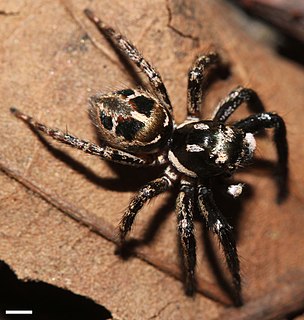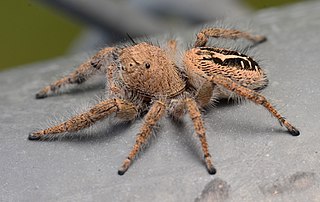Nops or NOPS may refer to:

Phidippus cardinalis is a species of jumping spider. It is commonly called cardinal jumper. It is one of the species of jumping spiders which are mimics of mutillid wasps in the genus Dasymutilla ; several species of these wasps are similar in size and coloration, and possess a very painful sting.

Hentzia is a genus of the spider family Salticidae subfamily Dendryphantinae. The genus is widespread in North America and northern South America but the center of biodiversity seems to be primarily in the Caribbean and surrounding areas, with the greatest species diversity occurring in Cuba, which has seven species. Some outlier species, such as Hentzia poenitens and Hentzia fimbriata are found in western North America. It appears to be closely related to the genus Anicius from which it differs primarily in certain anatomical details.

Ochyroceratidae is a six-eyed spider family, with 165 described species in ten genera. They are common inhabitants of caves and the tropical forest litter of South Africa, the Caribbean, Asia and South America. Considered an ecological counterpart of the Linyphiidae of the northern temperate zone, species are especially diverse in the Indo-Pacific region.
The Haplogynae or haplogynes are one of the two main groups into which araneomorph spiders have traditionally been divided, the other being the Entelegynae. Morphological phylogenetic studies suggested that the Haplogynae formed a clade; more recent molecular phylogenetic studies refute this, although many of the ecribellate haplogynes do appear to form a clade, Synspermiata.
Notnops is a monotypic genus of South American araneomorph spiders in the family Caponiidae, containing the single species, Notnops calderoni. It was first described by Norman I. Platnick in 1994, and has only been found in Chile. They have an orange carapace with yellow legs. Males have a body length of about 2 millimetres (0.079 in) long, and females are slightly larger, with a body length up to 3 millimetres (0.12 in).

The anatomy of spiders includes many characteristics shared with other arachnids. These characteristics include bodies divided into two tagmata, eight jointed legs, no wings or antennae, the presence of chelicerae and pedipalps, simple eyes, and an exoskeleton, which is periodically shed.

Anasaitis canosa, previously of the genus Corythalia, is a small jumping spider that can typically be found atop leaf-litter or man-made structures such as fences and exterior walls. This species is more commonly known as the twin-flagged jumping spider due to the two pennant shaped markings on the dorsal side of the cephalothorax. Typical of the genus Anasaitis, this species has iridescent setae ("scales") which may appear white, green or pink which create the "flags" as well as patches on the male pedipalps used in courtship and intraspecific signaling. This species is roughly 5 to 6 mm in length. A. canosa ranges from Mexico to South Carolina along the Gulf of Mexico.

Caponiidae is a family of ecribellate haplogyne spiders that are unusual in a number of ways. They differ from other spiders in lacking book lungs and having the posterior median spinnerets anteriorly displaced to form a transverse row with the anterior lateral spinnerets. Most species have only two eyes, which is also unusual among spiders. A few species of Caponiidae variously have four, six or eight eyes. In some species the number of eyes will increase when the spiderling changes its skin as it grows towards adulthood.

Cubanops is a genus of Caribbean araneomorph spiders in the family Caponiidae first described by A. Sánchez-Ruiz, Norman I. Platnick & N. Dupérré in 2010. These spiders are wandering hunters, generally found at ground level, under stones, in leaf litter or in the soil, and have only been found in the West Indies.

Nops is a genus of medium-sized South American, Central American, and Caribbean spiders in the family Caponiidae, first described by Alexander Macleay in 1839. It has a great richness on the Caribbean islands, and most mainland species are located in high proportion toward the Caribbean coast. It likely has a neotropical distribution, though most species of South America are known only from the coast of Colombia and Venezuela, including the islands of Aruba, Curaçao, Bonaire and Trinidad.

Tigrosa helluo is a species of spider belonging to the family Lycosidae, also known as wolf spiders. T. helluo was formerly known as Hogna helluo before differences between dorsal color patterns, habitat preferences, body structures, etc. were discovered. The species is native to the United States, Canada and Mexico. They can be found across the eastern half of the United States, primarily in the northeast and New England, and as far west as Nebraska and Kansas. T. helluo can be found in diverse habitats including woods, marshes, fields, and riparian areas. Typically, members of this species prefer to live in wetter areas as opposed to dry environments. Males tend to live for around a year and females will live for close to two years.
Caponina is a genus of araneomorph spiders in the family Caponiidae, first described by Eugène Simon in 1892.
Laoponia is a genus of Southeast Asian araneomorph spiders in the family Caponiidae, first described by Norman I. Platnick & Peter Jäger in 2008. As of April 2019 it contains only two species.
Nopsides is a monotypic genus of North American araneomorph spiders in the family Caponiidae, containing the single species, Nopsides ceralbonus. It is one of three nopine species, in addition to Tarsonops and Orthonops, described by Ralph Vary Chamberlin from specimens collected from the Baja California region and nearby islands in 1924. They are active during the night, hiding under large stones of Mexico's deserts and xeric shrublands during the day.

Habronattus mataxus is a species of jumping spider found in Texas and northern Mexico.

Phidippus texanus is a species of jumping spider in the family Salticidae. It is found in the United States and Mexico.
Diploglena proxila is a species of araneomorph spider in the family Caponiidae.
Caponina papamanga is a species of araneomorph spider from the Brazilian Amazonia. It is the first species of the genus Caponina from the region. It belongs to the family Caponiidae, which is described as ecribellate and haplogyne.

















